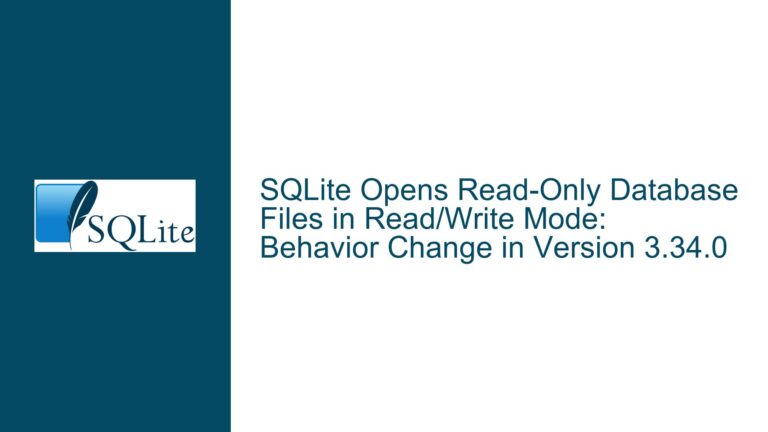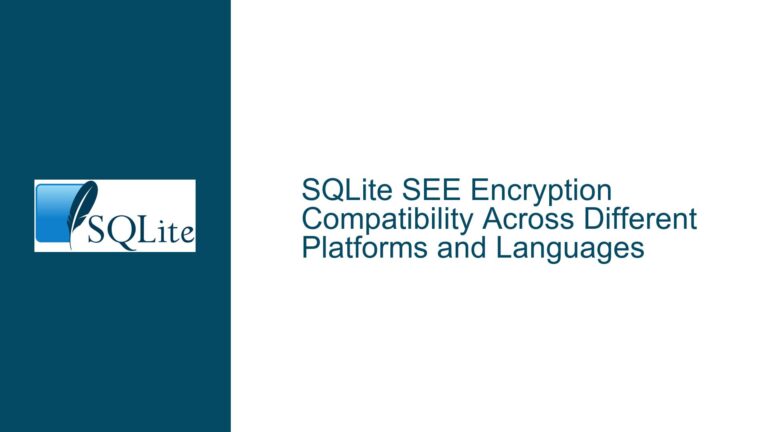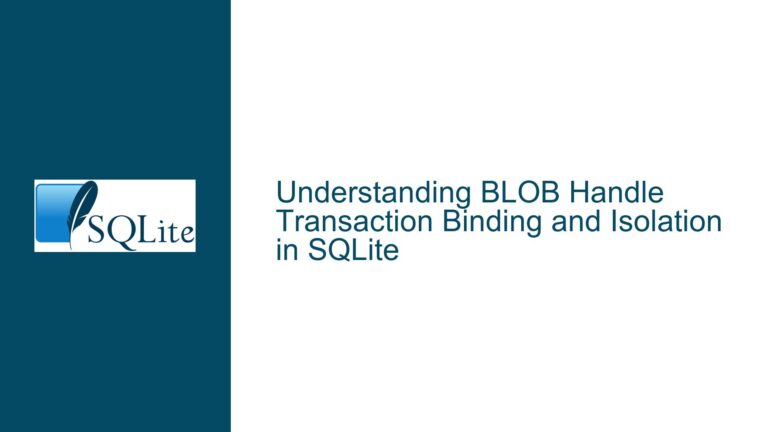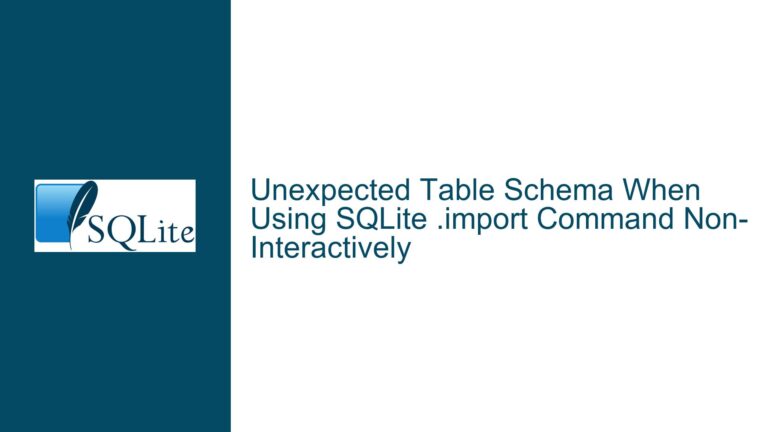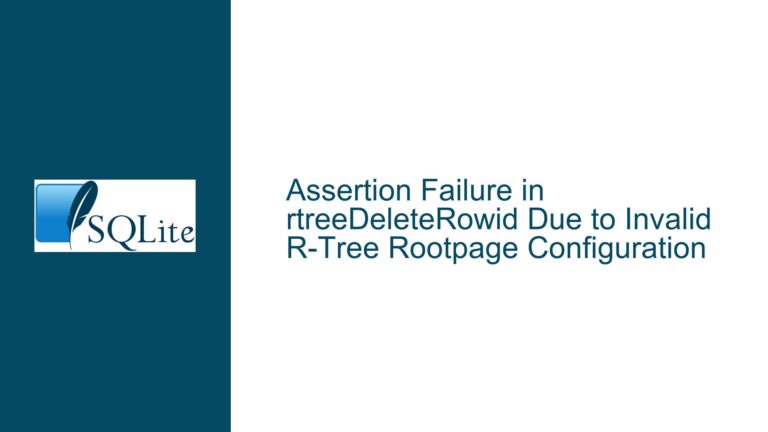SQLite 3.34.0 Read-Only Mode Configuration Issue
SQLite 3.34.0 Read-Only Mode Misconfiguration
In SQLite version 3.34.0, users have reported inconsistencies when attempting to open databases in read-only mode. Specifically, the .databases command displays r/w (read/write) instead of the expected r/o (read-only) when using the .open command with the --readonly option. This issue arises due to a misconfiguration in the command syntax, where the --readonly option is placed after the database file name instead of before it. This misplacement leads to the database being opened in read/write mode by default, despite the intention to open it in read-only mode.
The .open command in SQLite 3.34.0 has been enhanced to support various options, including --readonly, which allows users to open a database in a read-only state. However, the order of the options and the file name is crucial. Placing the --readonly option after the file name results in the option being ignored, causing the database to open in read/write mode. This behavior is consistent with the command-line parsing rules in SQLite, where options must precede the file name to be recognized and applied correctly.
For example, consider the following command:
sqlite> .open ./db/pubs.db --readonly
sqlite> .databases
main: D:\SQLite32\db\pubs.db r/w
Here, the --readonly option is placed after the file name, causing it to be ignored. As a result, the database is opened in read/write mode, as indicated by the r/w status in the .databases output.
In contrast, placing the --readonly option before the file name ensures that the database is opened in read-only mode:
sqlite> .open --readonly ./db/pubs.db
sqlite> .databases
main: D:\SQLite32\db\pubs.db r/o
In this case, the --readonly option is correctly recognized, and the database is opened in read-only mode, as indicated by the r/o status in the .databases output.
This issue highlights the importance of understanding the syntax and order of options in SQLite commands. Misplacing options can lead to unintended behavior, such as opening a database in read/write mode when read-only mode is desired. This can have significant implications, especially in environments where data integrity and security are critical.
Misplaced --readonly Option in .open Command
The primary cause of the issue is the incorrect placement of the --readonly option in the .open command. In SQLite, the order of options and arguments is significant, and the --readonly option must precede the file name to be effective. When the option is placed after the file name, it is treated as an argument rather than an option, leading to the database being opened in read/write mode by default.
The .open command in SQLite 3.34.0 supports several options, including --append, --deserialize, --hexdb, --maxsize, --new, --nofollow, --readonly, and --zip. These options must be specified before the file name to be recognized and applied correctly. For example:
sqlite> .open --readonly ./db/pubs.db
In this command, the --readonly option is correctly placed before the file name, ensuring that the database is opened in read-only mode.
However, if the --readonly option is placed after the file name, it is ignored, and the database is opened in read/write mode:
sqlite> .open ./db/pubs.db --readonly
In this case, the --readonly option is treated as an argument rather than an option, and the database is opened in read/write mode.
This behavior is consistent with the command-line parsing rules in SQLite, where options must precede the file name to be recognized and applied correctly. Misplacing options can lead to unintended behavior, such as opening a database in read/write mode when read-only mode is desired.
Correcting .open Command Syntax for Read-Only Mode
To ensure that a database is opened in read-only mode, the --readonly option must be placed before the file name in the .open command. This ensures that the option is recognized and applied correctly, resulting in the database being opened in read-only mode.
For example, consider the following command:
sqlite> .open --readonly ./db/pubs.db
sqlite> .databases
main: D:\SQLite32\db\pubs.db r/o
In this command, the --readonly option is correctly placed before the file name, ensuring that the database is opened in read-only mode, as indicated by the r/o status in the .databases output.
In contrast, placing the --readonly option after the file name results in the option being ignored, causing the database to be opened in read/write mode:
sqlite> .open ./db/pubs.db --readonly
sqlite> .databases
main: D:\SQLite32\db\pubs.db r/w
In this case, the --readonly option is treated as an argument rather than an option, and the database is opened in read/write mode.
To avoid this issue, users should always place the --readonly option before the file name in the .open command. This ensures that the option is recognized and applied correctly, resulting in the database being opened in read-only mode.
In addition to the --readonly option, the .open command supports several other options that can be used to control how a database is opened. These options include --append, --deserialize, --hexdb, --maxsize, --new, --nofollow, and --zip. Each of these options must be placed before the file name to be recognized and applied correctly.
For example, to open a database in append mode, the --append option must be placed before the file name:
sqlite> .open --append ./db/pubs.db
Similarly, to open a database as a new, empty database, the --new option must be placed before the file name:
sqlite> .open --new ./db/pubs.db
By understanding the syntax and order of options in the .open command, users can avoid unintended behavior and ensure that databases are opened in the desired mode.
In conclusion, the issue of databases being opened in read/write mode instead of read-only mode in SQLite 3.34.0 is caused by the incorrect placement of the --readonly option in the .open command. To resolve this issue, users should ensure that the --readonly option is placed before the file name in the .open command. This ensures that the option is recognized and applied correctly, resulting in the database being opened in read-only mode. By following this best practice, users can avoid unintended behavior and ensure that databases are opened in the desired mode.

